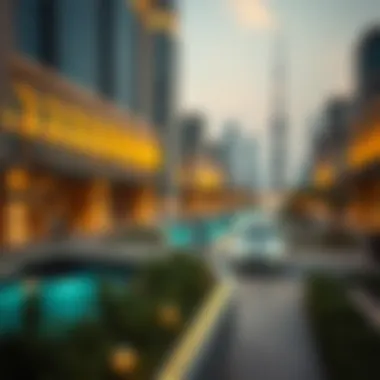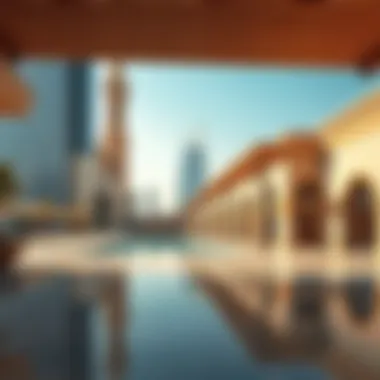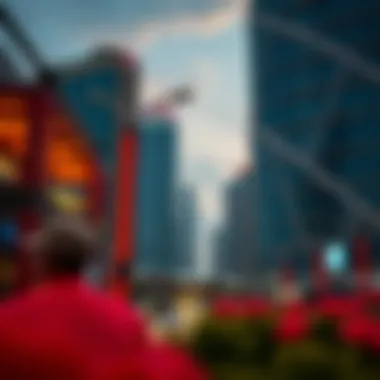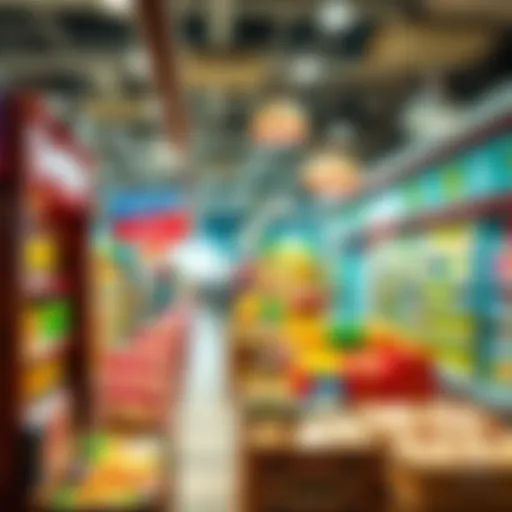Discovering Dubai: Top Nearby Attractions and Insights


Intro
In the vibrant landscape of Dubai, the attractions are not merely symbols of grandeur; they are living narratives that tell the story of the emirate's rapid transformation and cultural diversity. This guide aims to illuminate the various attractions that dot the diverse neighborhoods of Dubai, offering valuable insights tailored for discerning investors, homebuyers, and visitors alike. Whether you’re a seasoned resident, looking for a new property venture, or a curious traveler seeking to unearth hidden gems, understanding the dynamics of local attractions is paramount.
As we embark on this journey, we will delve into how geographical context shapes choice in attractions, the significance of these locales in enhancing the lifestyle of different demographics, and how they contribute to real estate value. By providing a rounded view and practical insights, this guide aims to equip you with the necessary tools to navigate your way through Dubai's attractions effectively. By the end of this exploration, one should be well-versed in how to appreciate Dubai beyond its surface glamour, understanding its pulse and the opportunities it presents.
Preamble to Local Attractions in Dubai
In the bustling city of Dubai, local attractions are not just leisure points; they embody the very essence of the city’s culture, history, and modern advancements. Understanding these attractions and their proximity can significantly enhance the experiences of both residents and visitors. The curated experiences around these sites can aid in making well-informed decisions, whether that involves investing in property close to these destinations or simply determining the best spots to visit during one’s stay.
The Importance of Proximity
When exploring Dubai, it becomes apparent that proximity is key. The city's attractions are often clustered together, turning what could be a tedious day of travel into a seamless exploration. For instance, the Dubai Mall stands next to the iconic Burj Khalifa, allowing visitors to ebb and flow between retail indulgence and awe-inspiring architecture without wasting a breath.
Being near attractions is beneficial for several reasons:
- Convenience: Easy access to entertainment and cultural experiences improves overall satisfaction for both tourists and residents.
- Property Value: Areas close to well-known attractions often see a boost in real estate prices, making them appealing for investors and homebuyers.
- Community Engagement: Local residents who are aware of attractions around them can participate more fully in community events and happenings.
Understanding Your Surroundings
To truly appreciate the charm of Dubai, one must get acquainted with their surroundings. Knowing what’s nearby can turn a mundane afternoon into an unexpected adventure. Local events, pop-up markets, or newly launched eateries can enhance the familiarity one has with their neighborhood.
- Historical Significance: Some attractions are steeped in history. Knowing their background can enrich visits and foster a deeper connection.
- Local Insights: Engaging with community members can provide insights about lesser-known spots that might not be highlighted in standard tourist guides. It’s often through these local recommendations that a visitor finds hidden gems.
- Cultural Context: Attractions vary in cultural significance. Understanding context can help in making respectful choices regarding visitation and engagement, which can greatly enhance the appreciation of one’s experience.
"Familiarity breeds comfort, and in a city as vibrant as Dubai, knowing your surroundings can prove to be a boon."
Ultimately, immersing oneself in the local scene — understanding its attractions, their significance, and proximity — can transform the experience of living in or visiting Dubai. This article aims to shed light on these dynamics, making it an essential guide for anyone looking to explore the myriad attractions that define this modern marvel.
Categories of Attractions
When exploring a city as vibrant as Dubai, understanding the categories of attractions near you can enhance the experience for both residents and tourists alike. Each category provides distinct opportunities to engage with the locale, offering different types of experiences that satisfy various interests. From enriching cultural insights to leisurely recreational spots, recognizing these categories is key for those looking to immerse themselves in the essence of Dubai.
Attractions can deeply influence one’s perception of a neighborhood, and understanding what each category has to offer can significantly inform decisions about living, working, or investing in an area. Moreover, categorization aids in recognizing the strengths and weaknesses of different locales, making it easier to choose where to visit or reside.
Cultural Attractions
Cultural attractions in Dubai provide a glimpse into the rich tapestry of history and tradition inherent to the region. Places such as the Dubai Museum and the Sheikh Mohammed Centre for Cultural Understanding reveal the heritage that shapes the emirate’s identity. Visitors gain valuable insights through exhibits that chronicle the city's transformation from a humble fishing community to a global metropolis.
Furthermore, events like the Dubai International Film Festival and art exhibitions at Alserkal Avenue showcase the contemporary cultural scene. These venues not only serve to educate but also to inspire dialogue among diverse communities. Engaging with such attractions fosters a deeper understanding of local norms and values, enriching one’s living experience in the area.
Recreational Spaces
Recreational spaces in Dubai are essential for balancing the busy urban life with leisure. Parks such as Safa Park and Al Barsha Park provide lush greenery that contrasts with the city’s concrete landscape. These areas allow for outdoor activities, from jogging to family picnics, fostering a sense of community.
Additionally, the iconic Dubai Marina Walk offers a scenic waterfront experience that combines dining, shopping, and entertainment. These recreational hubs are crucial for both mental and physical health, providing a respite from the hectic pace of city life. They attract families and individuals alike, enhancing the appeal of different neighborhoods.
Shopping Destinations
Dubai is synonymous with shopping, and its various shopping destinations cater to every inclination. From the luxury boutiques of The Dubai Mall to the traditional markets like the Gold Souk, the shopping landscape is diverse. The malls not only offer retail therapy but also serve as social gathering places where people can enjoy dining and entertainment under one roof.


Moreover, these destinations contribute to the economic vitality of different neighborhoods, attracting both locals and tourists. Being situated close to shopping centers can significantly enhance property value, making this aspect vital for potential investors.
Architectural Marvels
Architecture in Dubai is another testament to the emirate's rapid development and innovative spirit. Landmarks such as the Burj Khalifa and the twisting Cactus Tower serve as symbols of ambition and creativity. They draw architecture enthusiasts and casual visitors alike, offering guided tours that delve into their construction and design significance.
Recognizing these marvels is more than appreciating their aesthetic appeal; it’s about understanding the vision that drives Dubai’s growth. Such attractions elevate the overall profile of neighborhoods, making them more desirable places to visit or live.
"Every city has its own rhythm. Understanding that rhythm through its attractions is key to truly experiencing its essence."
Navigating the Landscape
Understanding how to navigate the landscape of attractions in Dubai is crucial for both residents and visitors. With a myriad of options ranging from cultural hotspots to leisure parks, effective navigation makes the experience not only more enjoyable but also more enriching. Utilizing tools, adapting to public transport systems, and assessing walkability can significantly influence accessibility and enhance the overall adventure in this vibrant city. Here, we break down these essential components to guide your exploration:
Use of Mapping Technology
In a constantly growing urban expanse like Dubai, mapping technology has become an indispensable ally. Popular apps like Google Maps and Waze offer real-time updates, guiding users effectively to their desired attractions. But the utility goes beyond mere direction; visualizing your proximity to various hotspots can reshape your itinerary in a heartbeat. For instance, if you're at the Dubai Marina, a quick glance at your map might lead you to discovering hidden art galleries or lesser-known cafes just around the corner. Moreover, many mapping applications provide user-generated content, showcasing updated reviews or tips to enhance your experience.
"Navigating the streets of Dubai is easier than ever when you have GPS and local insights working for you."
Another aspect to consider is compatibility; several platforms integrate seamlessly with public transport schedules. This offers a clear understanding of when to hop on the metro or a bus, ensuring you’re not left waiting in the sweltering heat. Hence, having a reliable mapping tool isn’t just for finding your way; it promotes a more enriched experience by enabling spontaneous discovery.
Public Transport Accessibility
Dubai's public transport system has developed into a well-oiled machine that caters to myriad attractions spread throughout the emirate. The metro network, buses, and trams connect diverse areas, making it easy to traverse the city without the hassle of traffic congestion or parking issues. Notably, the metro system runs frequently, allowing visitors to travel from the bustling Downtown area to the serene beaches of Jumeirah in no time.
When considering accessibility, it's essential to familiarize yourself with routes that link popular destinations, such as the Dubai Mall and the Burj Khalifa. This not only saves time but also ensures you experience the city's iconic landmarks without hefty taxi fares eating away at your budget. Additionally, with various payment options, including Nol cards usable across buses and the metro, the process feels intuitive and user-friendly.
Walkability of Key Areas
When exploring Dubai, walkability is often the hidden gem in ensuring a rewarding encounter with the city's attractions. Certain districts, like Al Fahidi, exude a charming atmosphere ideal for strolls, where art installations and quaint eateries lurk around every corner. The rhythm of walking allows for a more immersive experience as you encounter sights, sounds, and smells that a high-speed commute might overlook.
However, not all areas are designed with pedestrians in mind. That said, areas that prioritize walkability provide well-planned pathways and pedestrian zones, enhancing safety and convenience.
For effective walking tours, armed with a good pair of shoes and your smartphone, keep an eye out for local guided walking tours that not only cover historical aspects but also unearth local treasures. The souks for shopping, parks for leisure, and various eateries become more tangible when enjoyed on foot, creating a deeper connection with the surrounding culture.
In summary, navigating the landscape in Dubai through technology, public transport, and walkability creates a framework for uncovering the richness of the local attractions. Understanding these elements significantly enhances your experience, ultimately leading to a more meaningful exploration of what Dubai has to offer.
Evaluating Attractions
Evaluating attractions is a crucial compass guiding visitors and residents in their exploration of Dubai’s rich offerings. With a city as diverse and dynamic as Dubai, it’s imperative to assess not just what’s available but what resonates most with individual preferences and needs. This analysis offers insights into the intrinsic value of attractions, which can enhance one's personal experience, influence investment decisions, and foster a deeper understanding of the surrounding community.
Visitor Reviews and Testimonials
The opinions of previous guests hold significant weight. When one browses through visitor reviews, it becomes clear that personal experiences often paint a more vivid picture than any guidebook could do. These testimonials can reveal the atmosphere of a place, the quality of service, and the real value one might expect. For instance, a small cafe in Jumeirah might be highlighted for its intimate setting and authentic Emirati cuisine, while an expansive shopping mall may receive praise for its breathtaking architecture and diverse range of shops.
In many cases, travelers will detail their favorite and least favorite aspects, giving potential visitors valuable information. Online platforms like TripAdvisor or Yelp can serve as rich databases for this kind of feedback.
"Reviews not only recommend places, but frequently guide decision-making by pointing out hidden gems and potential disappointments."


Safety Considerations
Safety is, without a doubt, a priority for any attraction. In a city that welcomes millions of visitors each year, understanding safety protocols can make or break an experience. Places like the Dubai Mall are equipped with extensive security measures and clear evacuation plans in case of emergencies. Moreover, attractions often provide information regarding potential hazards, whether it’s related to physical activities like dune bashing or activities at height, such as the Burj Khalifa observation deck.
Residents and visitors alike should consult official sources, such as local government websites or your travel guides. It’s smart to stay up to speed on any advisories or concerns that might affect one’s plans.
- Look for:
- Emergency contacts
- Availability of first-aid services
- Presence of security personnel
Cost Analysis of Attractions
It’s beneficial to undertake a cost analysis when assessing attractions. Prices can vary widely, from the free-entry parks in Al Barsha to the high-ticket experiences like indoor skiing at Ski Dubai. Understanding the expected return on investment—be it financial or experiential—is key.
When planning outings, individuals should evaluate components such as:
- Admission fees
- Potential additional costs (food and souvenirs)
- Discounts or special passes that might be available
A benefit of evaluating costs is not just knowing what to spend; it also invites exploration of budget-friendly alternatives without sacrificing quality. Comparing attractions can lead visitors to unearth pockets of affordability amidst the lavishness for which Dubai is renowned.
By carefully scrutinizing these elements, one can traverse Dubai’s attractions without overshooting budgets and while maximizing enjoyment.
The Role of Attractions in Real Estate Decisions
When considering the dynamics of real estate in Dubai, it’s crucial to recognize the role that local attractions play in influencing property values and appeal. Real estate is not just about square footage; it’s about location, community, and the lifestyle that surrounds a property. The attractions that breathe life into a neighborhood can sway buyer perceptions and ultimately shape market trends.
Attraction Impact on Property Value
The presence of enticing attractions can significantly elevate property values. When buyers assess a potential home, they often consider amenities like parks, cultural venues, restaurants, and shopping centers. The more attractions available, the more desirable a location can become.
- Proximity to Landmarks: Living close to notable attractions such as the Burj Khalifa or the Dubai Mall can add a premium to property prices, as these landmarks draw tourists and locals alike. Properties nearby might command higher rents or prices than those further away.
- Lifestyle Convenience: For many residents, the convenience of enjoying leisure and social activities nearby is paramount. A vibrant local scene not only offers entertainment but also enhances daily life, making homes in such areas more appealing.
- Urban Development Trends: As municipalities invest in infrastructure and entertainment activities, neighborhoods that were once overlooked may surge in attractiveness, causing property values to crest as demand increases.
"In real estate, the nuances of what's nearby can be the difference between a house bought for a song and one that’s truly a jewel in the crown of investment."
Long-term Investment Considerations
Investing in properties near thriving attractions also carries both opportunities and potential risks that should be carefully weighed. The long-term view on these investments must consider various factors:
- Market Fluctuations: While localized attractions can enhance property value, it's essential to acknowledge that fluctuations in the market can still affect performance. Areas heavily reliant on tourism might suffer during downturns.
- Changing Tastes: As demographics shift, the attractions that once captivated may lose their charm, necessitating periodic reassessment of the property’s value and investment viability.
- Sustainability of Attractions: Investors should evaluate the longevity of nearby attractions. Are they government-supported, like parks or cultural initiatives, or are they reliant on private enterprise, such as specific restaurants or boutiques? Understanding this can inform future investment strategies.
In sum, the role of attractions in real estate decisions in Dubai cannot be overstated. They directly influence property desirability and investment stability while presenting a tapestry of choices that reflects the culture and vibrant life of the city.
Seasonality in Attraction Popularity
Understanding the ebb and flow of tourist traffic in Dubai plays a significant role in recognizing the value of local attractions. Seasonality significantly affects both the appeal and accessibility of various sites throughout the year. For investors, agents, and homebuyers, these fluctuations in visitor numbers can influence property values and rental prospects. Moreover, comprehending the seasonal variations can enhance the experience for tourists and locals alike, ensuring that they visit attractions at optimal times.
Tourist Seasons and Trends
Dubai's tourism can be characterized by distinct seasons, each reflecting various preferences and trends among visitors.


- Peak Tourist Season: This usually runs from November to April, coinciding with the city's cooler temperatures. Visitors flock from colder regions to bask in the pleasant weather and partake in various outdoor activities. Key attractions like the Dubai Marina, Burj Khalifa, and the Desert Safari tend to be bustling during these months. Higher demand during peak season also translates into increased rental prices, making it crucial for investors to be strategic about timing when entering or exiting the market.
- Shoulder Season: The months of May and October are considered shoulder seasons. During this time, tourist numbers begin to decline, but the weather can still be bearable for those seeking less crowded experiences. Visitors can still enjoy iconic landmarks without the throngs typically present in peak season. Investors should note that reduced visitor numbers can impact rental yields slightly; however, the opportunity to attract long-term residents increases.
- Low Season: The summer months of June to September see a noteworthy dip in tourist arrivals. The searing heat drives many away, except for those who prefer indoor excursions such as the Dubai Mall or various theme parks. This season can be tricky for investors, as the lower occupancy rates can affect property valuations. Nevertheless, this presents a unique chance for locals to explore leisure activities without the usual chaos.
Local Events Influencing Visits
Local events in Dubai serve as catalysts for attracting both tourists and residents, often shaping travel plans and interest in certain attractions.
- Cultural Festivals: Events such as the Dubai Shopping Festival and Ramadan Nights draw large crowds, emphasizing local culture while showcasing various attractions. For instance, during the shopping festival, visitors flood to the malls, benefiting not just shopping outlets but also nearby restaurants and entertainment venues. This results in a boon for nearby property owners, as foot traffic increases significantly.
- Sporting Events: Major sports events such as the Dubai Tennis Championships or Formula One races at Yas Marina Circuit in Abu Dhabi impact attractions as well. While these sporting spectacles may take place a bit outside Dubai, they coax tourists into the city, thus giving rise to higher occupancy rates in hotels and area residential properties.
- Art and Music Festivals: Initiatives such as the Al Quoz Art Festival or the Dubai Jazz Festival change the dynamics of attraction visits, drawing visitors who are eager to immerse themselves in cultural experiences. Local events can increase footfall while enhancing a sense of community, making it essential for investors to stay aware of the timing of such happenings to maximize exposure and interest in their properties.
"Recognizing seasonal patterns in visitor numbers is essential for making informed investment decisions in Dubai's dynamic property market."
To summarize, understanding seasonality in attraction popularity not only shapes the experience of tourists enjoying the vibrant offerings of Dubai, but it also provides critical insights for stakeholders considering investment opportunities. By keeping a finger on the pulse of tourist seasons and local events, one can capitalize on Dubai's ever-evolving tourism landscape, paving the way for both economic and experiential benefits.
Culinary Attractions Nearby
When it comes to exploring Dubai, the culinary attractions nearby are nothing short of a gastronomic paradise. With a rich tapestry woven from diverse cultures, the food scene in Dubai offers a delightful exploration of flavors that are both local and international. Understanding these culinary offerings is essential not just for food enthusiasts, but also for investors and homebuyers who recognize that a vibrant culinary landscape enhances a neighborhood's appeal, making it a crucial factor in real estate decisions.
The significance of culinary attractions goes beyond mere sustenance. They serve as cultural touchpoints, bringing communities together while also providing a unique lens through which visitors can experience the essence of Dubai. Engaging with the local food scene allows residents and tourists alike to appreciate the blend of tradition and innovation that is characteristic of this city.
Identifying Unique Dining Spots
Dubai is teeming with unique dining spots that push the envelope, offering menus that reflect both modernity and tradition. Areas like Al Fahidi and Jumeirah harbor hidden gems, where one can snag a table at an authentic Emirati restaurant, perhaps enjoying a traditional dish like al harees or khoubz. On the flip side, bustling areas like Dubai Marina and Dubai Mall are home to world-class international cuisine ranging from spicy Indian curries to authentic Italian pastas.
What sets these dining spots apart?
- Ambiance: Unique decor often tells a story, be it through traditional designs or chic modern aesthetics.
- Menu Creativity: Many eateries focus on utilizing seasonal ingredients, crafting fusion dishes that tantalize palates.
- Local Ingredients: Some restaurants emphasize local produce, contributing to sustainability and freshness.
Exploring these diverse dining establishments gives height to the culinary narrative in Dubai—bridging cultures and creating memorable experiences.
Food Festivals and Events
In addition to restaurants, Dubai plays host to an array of food festivals that attract both locals and tourists, making them quintessential experiences. Events such as the Dubai Food Festival and the Taste of Dubai highlight the region's culinary artistry through engaging activities, cooking demonstrations, and tastings.
During these festivals, attendees can:
- Sample Diverse Cuisines: From street food to gourmet delicacies, festivals offer a chance to indulge in various dishes from around the world.
- Meet Chefs and Food Influencers: Engaging with culinary experts provides behind-the-scenes insights into food preparation, enhancing appreciation for gastronomy.
- Participate in Workshops: Visitors often have the opportunity to join in cooking classes, learning to whip up local dishes under expert guidance.
Visiting these festivals not only satisfies one's appetite but also fosters community spirit and offers insights into the cultural richness of the UAE. As food is often tied closely to tradition and social gatherings, these events reinforce the role of culinary attractions in bringing people together.
"Food is a celebration of culture; every bite tells a story."
Culmination
In examining the myriad attractions available around Dubai, it's crucial to recognize the profound impact these locations can have on both the experiences of residents and the allure for visitors. Local attractions not only enhance the cultural fabric of the city but also play a significant role in influencing various aspects of life in Dubai, particularly for those involved in real estate or investment.
Recapping the Importance of Local Attractions
Local attractions serve as a vital part of the community identity and provide essential amenities that enrich the quality of life. From cultural landmarks to recreational spaces, these destinations shape not just the daily activities of individuals but also the overall vibrancy of neighborhoods.
- Cultural Significance: These attractions preserve the heritage and traditions of Dubai, allowing residents to connect with their roots while introducing visitors to the rich history of the region. The presence of these sites can enhance community pride.
- Economic Benefits: For investors and businesses, local attractions are more than just points of interest; they drive foot traffic which can enhance the value of nearby properties and stimulate economic growth. Locations that are popular with tourists often see a boost in real estate values, making them alluring options for potential buyers.
- Social Connectivity: They offer spaces for people to gather, fostering a sense of community. Parks, shopping districts, and entertainment venues provide opportunities for social interaction, which is especially important in a cosmopolitan city like Dubai where cultures intermingle.
Encouragement for Exploration
Exploring the attractions around you should never be an afterthought; it’s an invitation to discover hidden gems and enjoy everything your environment has to offer. Dubai, with its kaleidoscope of experiences, beckons residents and visitors alike to step beyond the ordinary.
- Go Beyond the Well-Known: While iconic sites like the Burj Khalifa draw the crowds, smaller, lesser-known attractions are often where the most genuine experiences lie. Delve into local markets or lesser-trodden parks to truly grasp the essence of the community.
- Participate in Local Events: From art festivals to food markets, local events provide a unique chance to engage with the culture and meet new people. These gatherings can showcase the city's diversity and creativity, enriching your understanding of the place.
- Food Adventures: Don't shy away from sampling local cuisine. Food tours can open the door to understanding the city's cultural dynamics while treating your palate to delightful flavors.
- Utilize Technology: Leverage mapping apps or local guides to navigate areas you might not be familiar with. This approach could lead you to delightful surprises—places that might not be in the typical guidebook but are brimming with character.
In essence, the call to explore is not just about sightseeing. It's about weaving yourself into the tapestries of the Dubai narrative, discovering its pulse, and appreciating the offerings that surround you. By immersing yourself in these dynamics, you not only enhance your experience but support the local ecosystem that thrives on each encounter. Explore, experience, and engage with the city—there's so much to uncover!







